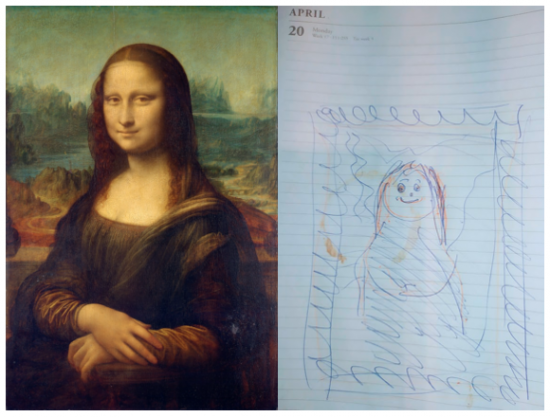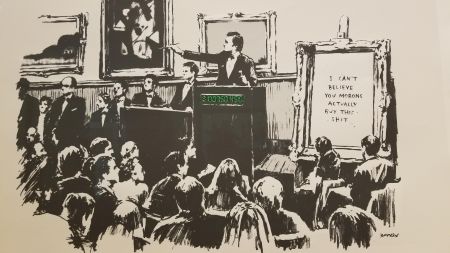Non-fungible token
|
New York, 8 March 2021. “Morons,” a “tokenized” artwork by Banksy, has sold for over $394,000 on the Open Sea NFT marketplace. The piece — burned by an unnamed group of cryptocurrency enthusiasts last week — was sold at an auction for 228.69 ethers (CRYPTO: ETH), which at press time traded at $1724.
- —JC NEWSWIRE
Non-fungible token
/nɒn-fʌnʤəbl/ /ˈtəʊkən/ (n.)
A unique reference to an external thing — for example, a Banksy artwork — that has been cryptographically encoded on a blockchain. The “NFT” does not, in itself, confer ownership on thing it represents, but — and unlike any of the millions of other copies and images of the work online — it is a unique token of your non-actual ownership — there is no other token of non-ownership quite like it (hence, “non-fungible”) and given its unique status on the bollockchain, no theoretical possibility another one that could be created. So this token somehow magically bootstraps itself to intrinsic value.
Hence some people — clearly possessed of a devastating sense of irony — hatched the idea of taking an already subversively self-referential artwork — one that plays with the idea of its own lack of intrinsic value, being a print — print 325 of 500 created! — created by a graffito which is called “Morons”, and which directly addresses the gullibility of art buyers, and which actually has the words “I CAN’T BELIEVE YOU MORONS ACTUALLY BUY THIS SHIT” written in capital letters on it — and putting a (er, non-representational) representation of it on the blockchain and selling that.
Still, the token sellers perceived rather bricks-and-mortar-ish, old-economy sort of perceptual problem: what if potential buyers worried that the physical piece might seem somehow more intrinsically valuable than its crypto-tokenized equivalent. Their solution: destroy the original work:
If you were to have the NFT and the physical piece, the value would be primarily in the physical piece. By removing the physical piece from existence and only having the NFT, we can ensure that the NFT, due to the smart contract ability of the blockchain, will ensure that no one can alter the piece and it is the true piece that exists in the world. By doing this, the value of the physical piece will then be moved onto the NFT.
There are two words I want to pick out from the above: “smart”, and “morons”. One of them is apposite.
And someone bought it, and you don’t even know for sure that that dude isn’t the gimp in all of this because — who can say? — someone else might buy it for more.[1] That is someone-call-Alanis-Morrissette staggering.
Creative destruction?
Let’s just work that logic through by analogy. Below, we have two images. One is La Gioconda. The other is a picture I just drew of it. I accidentally put my coffee mug down on it but I think that makes it look a bit more authentic. Now, both of these are unique representations: one is hanging in the Louvre, as we all know, the other is on the 20 April page from my desk diary from last year. Wikipedia estimates the 2019 value[2] of the Mona Lisa as USD 850 million. If we take that valuation as fair, I don’t think is is stretching things to say that the combined value of the Leonardo original and my unique token of it — to be clear, that is the real thing in my last year’s desk diary, not the feeble photographic facsimile below — is more or less exactly USD 850 million.

With me so far? Now for the krazy alchemical step. Let’s say we burn the Mona Lisa. We may need Robert Langdon to help with that I grant you but let’s just say. What is the value of my token now? EIGHT HUNDRED AND FIFTY BILLION BUCKAROONIES AM I RIGHT???
See also
References
- ↑ At the time of writing said buyer does seem to be the gimp: it bought for 228.69, and the offers that have flooded in to date have been in the range of 0.001 - 2 ether coins (that is $500 more than it is worth, but it puts it in some perspective.
- ↑ Extrapolated from a 1962 valuation of USD100m: a suspiciously round number if you ask me, but still.
